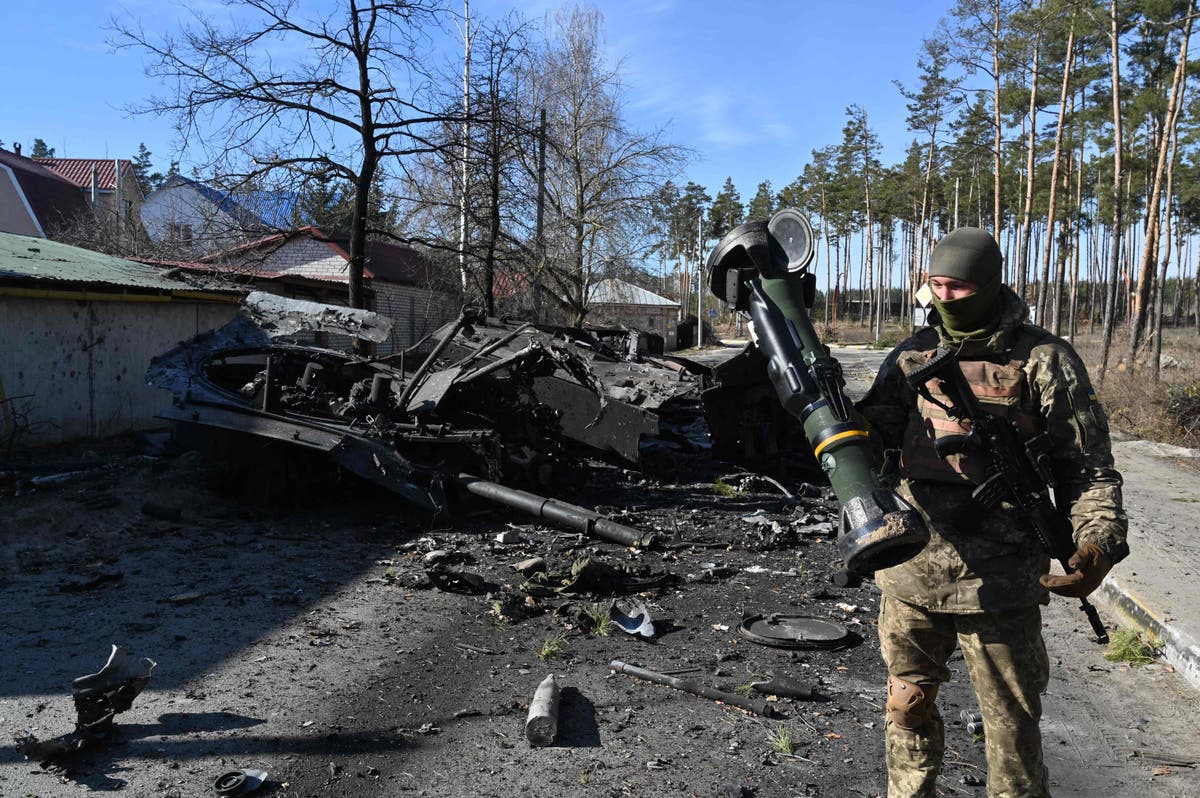
Fighting has intensified in the towns around Kyiv, as Russian troops continue in their attempts to isolate the Ukrainian capital before launching an assault with potentially devastating consequences.
Russian troops used artillery rounds to destroy homes at a string of locations, mainly to the east of the Dnipro River, during exchanges of fire with Ukrainian forces that were attempting to force them back from vantage points and intercept and destroy columns of armour.
Ukrainian presidential adviser Mykhailo Podolyak claimed that the capital was a “city under siege”, but that residents, as well as the country’s military, were “ready to fight” and ensure that “Kyiv will stand until the end”.
President Volodymyr Zelensky said on Saturday that Russia could only capture the capital if it “razes it to the ground”.
“They will come here only if they kill us all,” he said. “If that is their goal, let them come.”
This map shows the extent of Russia’s war in Ukraine (PA)
He also said that 1,300 Ukrainian troops had been killed in the first 17 days of the war.
The Kyiv government has claimed that Russian military losses stand at around 13,000. Western security sources put the number of fatalities at between 4,000 and 6,000. None of the sets of figures have been independently verified.
Troops and volunteer forces reinforced defensive fortifications while the digging of an extensive network of ditches around the perimeter of the capital continued. Units equipped with Javelin and N-LAW anti-tank missile systems were seen moving towards the northeast edges of the city.
A senior US defence official said: “We assess that the Russians are beginning to make more momentum on the ground towards Kyiv, particularly from the east,” while the Ministry of Defence in London held that “the bulk of Russian ground forces” were around 25km (15 miles) from the centre of Kyiv.
However, The Independent found on travelling out of Kyiv that there were no signs that towns such as Irpin or Bovary had fallen into Russia’s hands.
Weapons supplied by the west have played a significant part in Ukrainian successes on the battlefield. Russia’s deputy foreign minister warned on Saturday that western arms convoys to Ukraine could be “legitimate targets” for the Russian armed forces.
Sergei Ryabkov said: “We have warned the US that pumping weapons into Ukraine, which they have orchestrated from a number of countries, is not just a dangerous move – it is a move that turns these convoys into legitimate targets.
A wounded man is evacuated in the town of Irpin, outside Kyiv, on 12 March (Reuters)
“We have warned of the consequences that can result from this reckless transfer to Ukraine of such types of weapons as portable air-defence systems, anti-tank missile systems and so on.”
Talks, meanwhile, have continued between teams of Russian and Ukrainian delegates. Speaking of the possibility of a ceasefire, Mr Zelensky said: “Our diplomats are working and they have talked over some items of a possible agenda between us and the Russian Federation. I want this to materialise, and the process of ending the war, the process of peace, 100 per cent should begin with ceasefire.”
Mr Zelensky said he was open to direct talks with Vladimir Putin, and, in reference to the Russian president reportedly saying that progress was being made in the negotiations, added that he was “glad to see the signals from the Russian Federation”, adding: “For the last 12 years, I never heard words about the possibility of a dialogue.”
Away from Ukraine, the French and German leaders spoke for 90 minutes with President Putin in an attempt to negotiate a ceasefire. According to the Kremlin, Mr Putin laid out terms for ending the war, including Ukraine’s demilitarisation and its ceding of territory among other demands.
Those on Kyiv’s front line had little belief that peace would break out in the near future.
Valentin Zhuk, a member of a volunteer battalion, said: “The Russians have sent all these soldiers, all these weapons, because Putin wants Kyiv. I can’t see them getting pulled back now. We should be focusing totally now on how to defend Kyiv and throw back the Russians. That’s the only realistic option.”
Away from the capital, Russian forces have continued to pound the port city of Mariupol, and shelled a mosque that was sheltering more than 80 people, including children, the Ukrainian government said. There was no word on casualties.
President Volodymyr Zelensky speaking in Kyiv on 12 March (Ukraine Presidency/AFP/Getty)
The Ukrainian embassy in Turkey said 86 Turkish nationals, including 34 children, were among the people who had sought safety in Mariupol’s mosque of Sultan Suleiman the Magnificent and his wife Roksolana.
The encircled city has endured some of Ukraine’s worst misery since Russia invaded, with unceasing barrages thwarting repeated attempts to bring in food, water and medicine, evacuate trapped civilians, and even bury the dead. The death toll in Mariupol passed 1,500 on Friday.
With Mariupol’s electricity, gas and water supplies knocked out, aid workers and Ukrainian authorities described an unfolding humanitarian catastrophe.
Russia’s slow tightening of a noose around Kyiv alongside the bombardment of other cities mirrors tactics that Russian forces have previously used in other campaigns, notably in Syria and Chechnya, to crush armed resistance.








